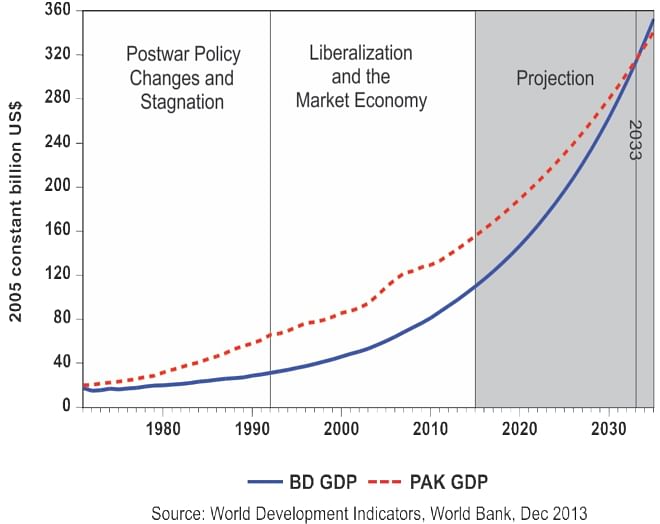Emergence of Bangladesh: Economic justification

Bangladesh separated itself from Pakistan and embarked on a Liberation War 43 years ago. A valid question may arise: Does our present economic performance justify the decision of our great leaders to be separated from Pakistan in 1971? While independence is always a basic right and has no alternative, this question may be answered from a purely economic point of view. Accordingly, comparing Bangladesh's economy with Pakistan's becomes imperative. Although there are numerous variables to compare two economies, this writing focuses only on the major macro variables: gross domestic product (GDP) and per capita income (PCI).
Using the World Bank data for these two countries, three phases have been demarcated for comparison, as shown in the diagram. The first phase includes policy changes from socialist planning to capitalist transition by comprising the regimes of Bangabandhu, General Zia, and General Ershad. The second phase marks the reforms spreading over multiple regimes of Khaleda Zia and Sheikh Hasina. The third phase is constructed on projection by using the data of the 2001-2012 period.
The diagram shows that in 1972, Bangladesh's GDP was three-fourth the size of Pakistan's GDP. Pakistan overgrew Bangladesh in the years since until the early 1990s. Despite postwar anomalies, Bangladesh grew at 4% over the 1972-1979 period when Pakistan grew at 5%, making the relative output comparison even worse for us. Bangladesh's GDP volume slid down to 60% of the corresponding Pakistani figure at the end of the 1970s.
Our output difference with Pakistan continued to widen in the regimes of President Zia and President Ershad, who witnessed Bangladesh's highest growth differential with Pakistan. In the 1980s, Pakistan left Bangladesh far behind in output by growing at as high as 7% when Bangladesh grew poorly at 3%, further reducing the comparative output share for Bangladesh to as low as 50% of Pakistan's GDP volume. Thus, Bangladesh reaches its lowest point in comparison with Pakistan in terms of the size of the economy in 1992.
The turning point for Bangladesh emerged in the early 1990s along with the new era of democratisation. The country embarked on liberalisation to engineer a new trajectory of growth, and began to outperform Pakistan by reaping the harvests of democracy and globalisation, but Pakistan failed considerably in this regard. Bangladesh electrified a new growth path by jumping up from 3% growth in the 1980s to 5% in the 1990s. Conversely, Pakistan's growth slid down from 7% in the 1980s to 4% in the 1990s, and the country could not escape the trap of 4% growth in the 2000s, and even until today. In contrast, Bangladesh accelerated to reach the 6% level over the 2000s and beyond.
The gradual strengthening of the market economy and liberalisation over the last two decades empowered Bangladesh to outgrow Pakistan in a consistent manner. In 1971, Pakistan had never imagined that a war-ravaged country like Bangladesh would ever stand up, and so did many Washington policymakers including President Nixon and diplomat Kissinger. But the reversal of fate began to sprout since the early 1990s. Bangladesh started to unleash its potential that challenged Pakistan's economic capacity, making the dream of our great leaders come true.
Based on the average growth rates of the last 12 years (2001-2012), which was 6% for Bangladesh and 4% for Pakistan, it can be projected that Bangladesh will exceed the size of Pakistan's economy by 2033. Simply, Bangladesh will surpass a South Asian giant in 20 years, which was almost unthinkable just 20 years ago when Pakistan's economy was twice as big as Bangladesh's.
The story of per capita income (PCI) is even more interesting. Pakistan's PCI was double the size of Bangladesh's in 1992. Given the trend of growth in PCI, Bangladesh is most likely to exceed Pakistan's PCI in less than 10 years, say, by 2023 -- 10 years earlier than when Bangladesh's GDP will exceed Pakistan's. Bangladesh enjoys a cutting edge in PCI mainly because of its successful population control, productive education, women empowerment, and encouraging social indicators -- some of them are even brighter than India's.
Over the last 12 years (2001-2011), while Pakistan's population growth was close to 2%, Bangladesh's was slightly over 1%. Bangladesh's youth literacy is 79% (2011) and Pakistan's 71% (2009). Moreover, the curricula and quality of Pakistan's education warrant further investigation as to why the country's education is not reflecting a desirable level of productivity growth. Over the last 12 years (2001-2012), Bangladesh's PCI growth (4.57%) was more than double of Pakistan's (2.2%), making the reversal of fate inevitable. After 43 years of independence, Bangladesh can now proudly justify its separation from Pakistan through the lens of the economy.
The writer is Associate Professor of economics at the State University of New York at Cortland.

 For all latest news, follow The Daily Star's Google News channel.
For all latest news, follow The Daily Star's Google News channel. 



Comments